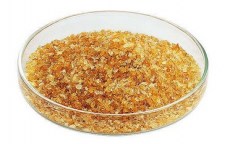

Still the preferred adhesive for cabinetmaking and instrument making where the glue needs to be reversible. Packed either by weight in plastic bags or by volume in resealable plastic jerry cans.
Note: As at the end of 2020 we are supplying a European sourced version of hide glue. This is due to a shortage of the New Zealand sourced product because of factory fire.
The alternative is a granulated finer grind rather than a droplet form. Feedback is requested on this change of item.
HIDE GLUE
Pearl Joiners hide glue is a naturally derived gelatinous glue extracted from animal skins and bones.
The use of glues by humankind has a fascinating history. The majority of modern adhesives or glues are creations of modern chemistry and traditional natural adhesives are progressivley being sidelined with one notable exception, that of animal protein glues.
The use of glue made by rendering animal skin, bones and teeth dates back about 6000 years in antiqiuity and it remains to this day the adhesive of choice for high value pieces which have to be able, as part of their design brief, to be disassembled and re-glued during periodic restoration or repair. Woodwind instruments are a typical candidate but the use of hide glues find wide application across woodworking. For these users the thought of using an epoxy resin is an abomination.
Hide glues have none of the safety issues common with modern glue formulations (although do keep away from pets - a customer of mine once asked for a follow up kilo bag because his dog ate the first one! To no serious affect apparently).
Hide glue has good gap filling properties and, unlike numerous modern adhesives, will meld with and stick to older remnants of itself and re-establish a strong bond, a very useful attribute which means you may not need to remove all old glue from joints during a repair. It sets quickly and bonded pieces can be taken apart at any later time with the careful use of hair dryers, hot water on rags or the application of steam. You can also loosen hide glue joints when dis-assembling a piece by injecting 100% alcohol - see HERE - into the joint. See syringes for injecting joints and veneer bubbles HERE.
Very importantly hide glue has a neutral pH (the measure of relative alkalinity and acidity) which is a major consideration for the expected service life of pieces made to last centuries.
Mixing
Add equal weights of hide glue and water (rainwater is best) and allow to stand for 20 minutes or so.
Heat the mix in a double boiler. A double boiler is a outer container with a jacket of water into which an inner container is placed and allowed to heat up. For small intermittent jobs metal containers are fine, a plastic lined vegetable can sitting in a fry pan for example. Heat the mix to around 80 degrees C, (a coffee making thermometer is a perfect tool to accurately monitor the temperature).
Do NOT BOIL under any circumstances. The glue is ready when it has the consistency of a medium thickness soup.
It is best to mix only what is needed and discard the completely biodegradable leftovers although in cabinet shops, in times past, the first job of the apprentice each day was to top up the glue pot which indicates the use of hide glue is not a fussy issue.
Applying
Apply to both faces and bring together as quickly as possible. The corner braces so common in old cabinet pieces are frequently held on with hide glue. Apply the glue to the mating faces, squeeze the brace in to place by hand and rub back and forth until it cools and catches. For an afficionados approach use Linden Bas wood fibre brushes rather than animal hair brushes which may contaminate the hide glue.
Strength
Gelatin glues are strength rated using a bloom test. Wiki link reference.
Related Products
We market pearl hide glue and rabbit skin glue. For larger jobs, or when equipping for continual use of hide glues, we also market thermostatically controlled double boiler appliances specifically made for this application.
Specialist repairers and makers would never use brushes made from animal hairs to apply the glue lest there be contamination and an affect on the ideal pH of the glue. They use Linden Bas brushes which are a piece of European Lime wood with its fibres hammered out to resemble an animal hair brush. Over time bas brushes are simply hammered out to provide fresh fibre.
-------------------------------------------------------------------------------
The Relevant parts of Manufacturers Product Specification
DESCRIPTION
A low viscosity pearl animal glue, amber in colour with a typical bovine odour.
SPECIFICATIONS
| ANALYTICAL | TEST METHOD | |
| Viscosity | 40-55mps | LAB010A |
| Double bloom | 100-200g | LAB003 |
| Moisture | <16% | LAN012 |
| Ash | <5% | LAB011 |
| pH | 5.0~7.0 | LAB006 |
STORAGE
Bags should be stored in a cool, dry area. When so stored there should be no
major changes in product properties for a period of five years.


